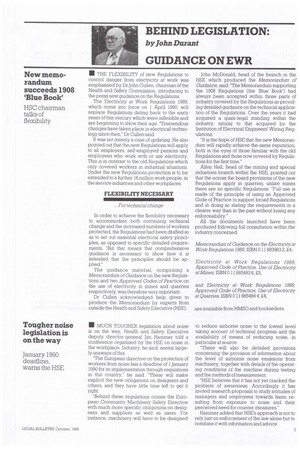BEHIND LEGISLATION:
Page 155

If you've noticed an error in this article please click here to report it so we can fix it.
by John Durant
GUIDANCE ON EWR
In THE FLEXIBILITY of new Regulations to control danger from electricity at work was emphasised by Dr John Cullen, chairman of the Health and Safety Commission, introducing to the press new guidance on the Regulations.
The Electricity at Work Regulations 1989, which come into force on 1 April 1990, will replace Regulations dating back to the early years of this century which were inflexible and are beginning to show their age. "Tremendous changes have taken place in electrical technology since then," Dr Cullen said.
It was not merely a case of updating He also pointed out that the new Regulations will apply to all employers, self-employed persons and employees who work with or use electricity. This is in contrast to the old Regulations which only covered workers in industrial situations Under the new Regulations protection is to be extended to a further 16 million work people, in the service industries and other workplaces.
FLEXIBILITY NECESSARY For technical change
In order to achieve the flexibility necessary to accommodate both continuing technical change and the increased numbers of workers protected, the Regulations had been drafted so as to set out essential electrical safety principles, as opposed to specific detailed requirements. 'But that means that comprehensive guidance is necessary to show how it is intended that the principles should be applied."
The guidance material, comprising a Memorandum of Guidance on the new Regulations and two Approved Codes of Practice on the use of electricity in mines and quarries respectively, was therefore very important.
Dr Cullen acknowledged help given to produce the Memorandum by experts from outside the Health and Safety Executive (HSE).
John McDonald, head of the branch in the HSE which produced the Memorandum of Guidance, said: "The Memorandum supporting the 1908 Regulations (the 'Blue Book') had always been accepted within those parts of industry covered by the Regulations as providing detailed guidance on the technical application of the Regulations. Over the years it had acquired a quasi-legal standing within the industry, similar to that acquired by the Institution of Electrical Engineers' Wiring Regulations.
it is the hope of HSE that the new Memorandum will rapidly achieve the same reputation, both in the eyes of those familiar with the old Regulations and those now covered by Regulations for the first time."
Allen Hall, head of the mining and special industries branch within the HSE, pointed out that the across the board provisions of the new Regulations apply in quarries; unlike mines there are no specific Regulations. "Full use is made of the principle of using an Approved Code of Practice to support broad Regulations and in doing so stating the requirements in a clearer way than in the past without losing any enforceability."
All the documents launched have been produced following full consultation within the industry concerned.




























































































































































